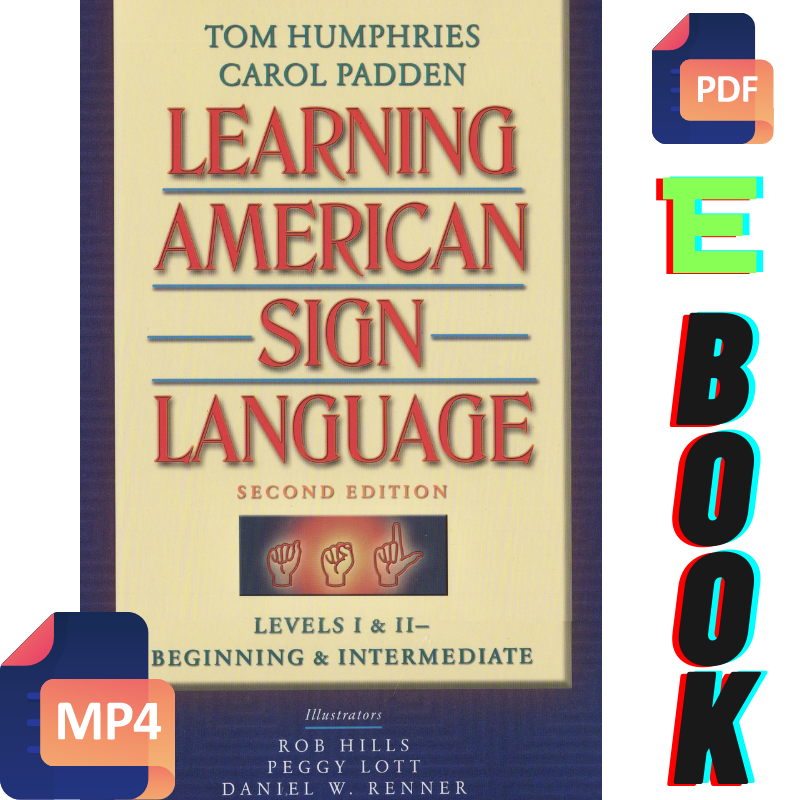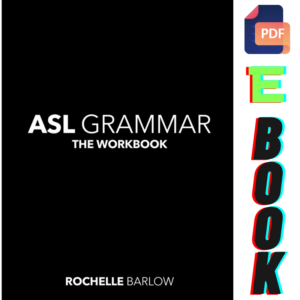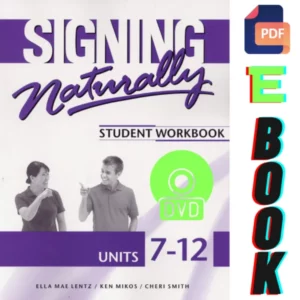Master ASL Fluency with Learning American Sign Language: 2nd Edition
For learners seeking a rigorous, grammar-focused approach to ASL, Learning American Sign Language: 2nd Edition by Tom Humphries and Carol Padden stands as a cornerstone textbook. Combining 20 structured lessons with immersive DVD demonstrations, this resource bridges linguistic mastery with cultural competency, making it a top choice for academic settings and dedicated self-learners.
Why Choose Learning American Sign Language: 2nd Edition?
First published in 2004 and revised in 2013, this textbook offers a systematic framework for mastering ASL syntax, vocabulary, and Deaf cultural norms. Adopted widely in high schools, colleges, and universities, its academic rigor distinguishes it from conversational-focused alternatives like Signing Naturally.
Key strengths include:
- Grammar-Centric Approach: Detailed breakdowns of ASL sentence structure, non-manual markers, and classifiers.
- Revised Cultural Content: Updated insights into Deaf community practices, history, and identity.
- DVD Integration: 2.5+ hours of video featuring native ASL signers demonstrating dialogues and narratives.
Core Features of the 2nd Edition
1. Structured Curriculum
The textbook’s 20 lessons progress from basic vocabulary to complex discourse, featuring:
- Dialogues & Exercises: Each lesson includes practice scenarios, vocabulary lists, and homework assignments.
- Grammar Notes: Clear explanations of rules like topicalization and role-shifting.
- Fingerspelling Drills: Targeted exercises for improving receptive and expressive skills.
2. DVD Demonstrations
The accompanying DVD enhances learning with:
- Native Signer Models: Slow-motion replays clarify handshapes and movement.
- Real-Time Conversations: Unscripted interactions mimic natural ASL pacing.
- Cultural Vignettes: Short films on Deaf artists, educators, and historical milestones.
3. Deaf Culture Integration
Cultural notes embedded in lessons cover:
- Community Values: Importance of Deaf clubs, storytelling traditions, and advocacy.
- Historical Context: Profiles of pioneers like Andrew Foster and modern activists.
Ideal Users
Academic Institutions
Widely used in ASL courses at universities like UC San Diego and Gallaudet, the textbook aligns with credit-bearing curricula.
Self-Motivated Learners
While designed for classrooms, the DVD and answer key (sold separately) enable independent study. One user noted, “The grammar explanations are clearer than any YouTube tutorial”.
ASL Instructors
Teachers benefit from supplemental lesson plans and a test bank, though additional resources may be needed for interactive activities.
Pricing & Editions
Prices range from $35 (used paperback) to $120 (new with DVD). To ensure DVD inclusion:
- Trusted Retailers: Purchase from Pearson Education, Amazon, or university bookstores.
- Edition Note: The 2013 2nd edition supersedes older versions, with updated cultural content.
Comparison to Similar Resources
| Feature | Learning ASL 2nd Ed | Signing Naturally |
|---|
| Focus | Grammar & syntax | Conversational fluency |
| Video Content | 2.5+ hours (DVD) | 7.5+ hours (DVDs) |
| Cultural Depth | Historical & community | Modern norms & bios |
| Self-Study Support | Answer key sold separately | Built-in self-checks |
FAQs
Q: Is this book suitable for beginners?
A: Yes, but it’s best paired with instructor feedback or supplemental video resources for practice.
Q: Are the DVDs region-locked?
A: Most copies are Region 1 (U.S./Canada), but check retailer details for international buyers.
Q: How does this compare to The American Sign Language Phrase Book?
A: This textbook emphasizes grammar and long-term fluency, while phrasebooks prioritize quick conversational skills.
Elevate Your ASL Expertise
Learning American Sign Language: 2nd Edition remains unmatched for learners committed to mastering ASL’s linguistic structure while engaging deeply with Deaf culture. Whether you’re a student, educator, or independent learner, this textbook provides the foundation for meaningful, grammatically precise communication.
Start your journey today—secure your copy from trusted academic retailers and unlock 2.5+ hours of expert ASL instruction!
Learning American Sign Language 2nd Edition Learning American Sign Language 2nd Edition
Learning American Sign Language: Beginning and Intermediate, Levels 1-2, 2nd edition is a comprehensive guide to learning the basics of American Sign Language (ASL). This ebook covers the history, structure, and culture of ASL and the vocabulary, grammar, and communication skills needed for everyday interactions. You will learn how to sign numbers, colors, family members, emotions, directions, and more, with clear illustrations and videos to help you practice. You will also discover the rich and diverse aspects of Deaf culture, such as Deaf art, literature, and humor. Whether you are a student, a professional, or a curious learner, this ebook will help you master the fundamentals of ASL and appreciate its beauty and diversity.
“Learning American Sign Language: Second Edition” by Tom Humphries and Carol Padden is a comprehensive guide designed to help students and educators alike in learning and teaching American Sign Language (ASL). The book serves both as a language textbook and a cultural introduction to the Deaf community, providing a holistic approach to learning ASL. Here’s a detailed summary of the book:
Structure and Content
The book is structured into various chapters, each focusing on different aspects of ASL and Deaf culture. It is divided into lessons, which include vocabulary, grammar, and exercises to reinforce learning.
Introduction
The introduction outlines the importance of ASL and its unique structure compared to English. It emphasizes ASL as a complete, natural language with its own syntax and grammar, not merely a collection of gestures or a manual representation of English.
Lessons
Each lesson introduces new vocabulary and grammatical concepts. The lessons are designed to build upon each other progressively, ensuring that learners can develop a solid foundation before moving on to more complex aspects of the language.
- Vocabulary: Each lesson begins with a list of new signs. Illustrations or descriptions of how to perform each sign are provided.
- Grammar and Syntax: Lessons include explanations of grammatical rules and structures unique to ASL, such as non-manual signals, facial expressions, and sentence structure.
- Exercises: Practical exercises help reinforce the material. These include both individual and group activities, promoting interactive learning.
- Cultural Notes: Throughout the book, cultural notes provide insights into Deaf culture, etiquette, and history, fostering a deeper understanding and respect for the Deaf community.
Visual and Interactive Elements
The book includes numerous illustrations and photographs to demonstrate signs and non-manual signals. These visual aids are crucial for learners to replicate signs and understand their nuances accurately.
Special Features
- Dialogues and Conversations: Sample dialogues and conversations illustrate how signs are used in context. These examples are useful for understanding the flow of ASL in real-life situations.
- Receptive and Expressive Skills: Activities are designed to develop both receptive (understanding) and expressive (signing) skills. Receptive skills are honed through exercises that require interpreting signed sentences or stories, while expressive skills are developed through practice in signing accurately and fluently.
- Review and Practice: Regular review sections help reinforce previously learned material. These sections include practice exercises and quizzes to test comprehension and retention.
- Cultural Insights: The book integrates cultural information seamlessly with language instruction. This dual focus helps learners appreciate the context in which ASL is used, fostering greater empathy and cultural sensitivity.
Appendices
The appendices provide additional resources, including:
- Sign Index: A comprehensive index of signs covered in the book for quick reference.
- Grammar Index: An index of grammatical concepts discussed throughout the lessons.
- Further Reading and Resources: Recommendations for further reading and additional resources for learners interested in deepening their understanding of ASL and Deaf culture.
Conclusion
“Learning American Sign Language: Second Edition” is a well-rounded educational tool that not only teaches the mechanics of ASL but also immerses learners in the cultural context of the Deaf community. Its structured approach, combined with rich visual aids and cultural insights, makes it an effective resource for anyone looking to learn ASL, whether for personal, professional, or academic purposes.
FAQs for Learning American Sign Language 2nd Edition
1. What is “Learning American Sign Language 2nd Edition” about?
The book is a comprehensive guide designed to teach American Sign Language (ASL) and provide cultural insights into the Deaf community. It covers vocabulary, grammar, and practical exercises, integrating visual aids and cultural notes to foster a deeper understanding of ASL and Deaf culture.
2. Who are the authors of the book?
The book is authored by Tom Humphries and Carol Padden, both of whom are renowned educators and experts in ASL and Deaf studies.
3. Is this book suitable for beginners?
Yes, the book is structured to cater to beginners, starting with basic vocabulary and grammar and progressively building up to more complex concepts. It is designed to be accessible to those with no prior knowledge of ASL.
4. Does the book include visual aids to help learn signs?
Yes, the book includes numerous illustrations and photographs demonstrating how to perform each sign, which is crucial for accurately learning ASL.
5. Are there exercises and practice activities in the book?
Yes, each lesson contains exercises and activities designed to reinforce learning. These include individual and group activities, as well as receptive and expressive skills practice.
6. Does the book cover ASL grammar and syntax?
Yes, the book provides detailed explanations of ASL grammar and syntax, including non-manual signals, facial expressions, and sentence structure.
7. Are there cultural notes included in the book?
Yes, the book integrates cultural notes throughout the lessons to provide insights into Deaf culture, etiquette, and history, helping learners understand the context in which ASL is used.
8. Can this book be used for self-study, or is it better suited for classroom use?
The book is designed to be versatile and can be used effectively for both self-study and classroom instruction. The structured lessons and comprehensive resources make it suitable for various learning environments.
9. Is there an index of signs and grammar concepts in the book?
Yes, the appendices include a sign index for quick reference and a grammar index to help learners navigate the grammatical concepts covered in the lessons.
10. Does the book provide resources for further learning?
Yes, the book includes a section with recommendations for further reading and additional resources for those interested in deepening their understanding of ASL and Deaf culture.
11. How is the book structured?
The book is divided into lessons, each focusing on specific vocabulary and grammatical concepts. Lessons include vocabulary lists, grammar explanations, exercises, dialogues, cultural notes, and review sections.
12. What makes this book different from other ASL learning resources?
“Learning American Sign Language: Second Edition” stands out due to its comprehensive approach, combining language instruction with cultural education. The integration of visual aids, practical exercises, and cultural insights provides a holistic learning experience.
13. Is there a digital or online version of the book available?
Check the publisher’s website or major online bookstores for information on digital or online versions of the book, as availability may vary.
14. Can this book help with developing both receptive and expressive ASL skills?
Yes, the book includes activities designed to develop both receptive (understanding signed language) and expressive (producing signed language) skills, ensuring a well-rounded proficiency in ASL.
15. What kind of supplementary materials are provided in the book?
In addition to the main lessons, the book includes appendices with sign and grammar indexes, further reading recommendations, and various exercises and quizzes to reinforce learning.




Tania –
“Learning American Sign Language 2nd Edition” is a comprehensive textbook for ASL learners. This edition builds on the strengths of its predecessor, offering updated content and enhanced learning materials.
Pros:
Well-structured lessons suitable for beginners to intermediate learners
Includes cultural information alongside language instruction
Clear illustrations and explanations of sign formations
Practice exercises reinforce learning
Cons:
Some users may find the pace slow, especially if they have prior experience
As a textbook, it lacks the interactive elements of digital resources
The purchasing experience from aslbk.com was generally smooth, with timely delivery of the product. However, individual experiences with the seller may vary.
Overall, this textbook serves as a solid foundation for those serious about learning ASL, whether in a classroom setting or for self-study. It’s particularly useful for visual learners who appreciate detailed explanations and illustrations.